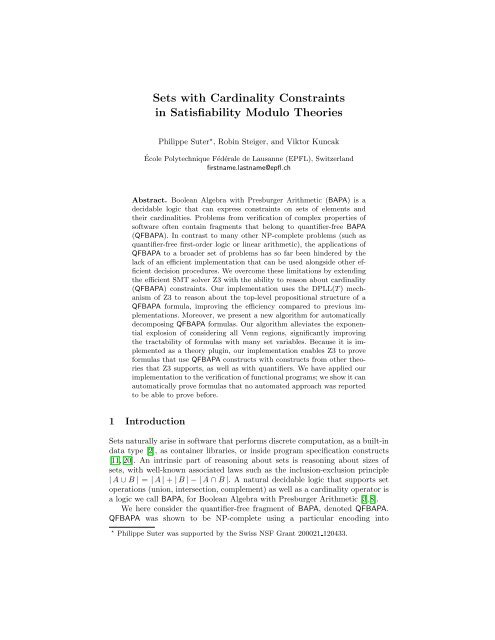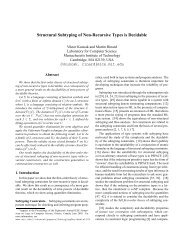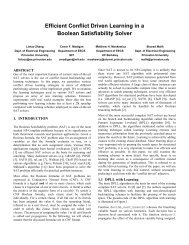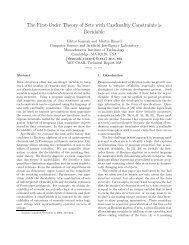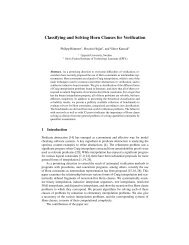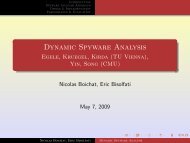Sets with Cardinality Constraints in Satisfiability Modulo Theories
Sets with Cardinality Constraints in Satisfiability Modulo Theories
Sets with Cardinality Constraints in Satisfiability Modulo Theories
You also want an ePaper? Increase the reach of your titles
YUMPU automatically turns print PDFs into web optimized ePapers that Google loves.
<strong>Sets</strong> <strong>with</strong> <strong>Card<strong>in</strong>ality</strong> <strong>Constra<strong>in</strong>ts</strong><br />
<strong>in</strong> <strong>Satisfiability</strong> <strong>Modulo</strong> <strong>Theories</strong><br />
Philippe Suter ⋆ , Rob<strong>in</strong> Steiger, and Viktor Kuncak<br />
École Polytechnique Fédérale de Lausanne (EPFL), Switzerland<br />
firstname.lastname@epfl.ch<br />
Abstract. Boolean Algebra <strong>with</strong> Presburger Arithmetic (BAPA) is a<br />
decidable logic that can express constra<strong>in</strong>ts on sets of elements and<br />
their card<strong>in</strong>alities. Problems from verification of complex properties of<br />
software often conta<strong>in</strong> fragments that belong to quantifier-free BAPA<br />
(QFBAPA). In contrast to many other NP-complete problems (such as<br />
quantifier-free first-order logic or l<strong>in</strong>ear arithmetic), the applications of<br />
QFBAPA to a broader set of problems has so far been h<strong>in</strong>dered by the<br />
lack of an efficient implementation that can be used alongside other efficient<br />
decision procedures. We overcome these limitations by extend<strong>in</strong>g<br />
the efficient SMT solver Z3 <strong>with</strong> the ability to reason about card<strong>in</strong>ality<br />
(QFBAPA) constra<strong>in</strong>ts. Our implementation uses the DPLL(T ) mechanism<br />
of Z3 to reason about the top-level propositional structure of a<br />
QFBAPA formula, improv<strong>in</strong>g the efficiency compared to previous implementations.<br />
Moreover, we present a new algorithm for automatically<br />
decompos<strong>in</strong>g QFBAPA formulas. Our algorithm alleviates the exponential<br />
explosion of consider<strong>in</strong>g all Venn regions, significantly improv<strong>in</strong>g<br />
the tractability of formulas <strong>with</strong> many set variables. Because it is implemented<br />
as a theory plug<strong>in</strong>, our implementation enables Z3 to prove<br />
formulas that use QFBAPA constructs <strong>with</strong> constructs from other theories<br />
that Z3 supports, as well as <strong>with</strong> quantifiers. We have applied our<br />
implementation to the verification of functional programs; we show it can<br />
automatically prove formulas that no automated approach was reported<br />
to be able to prove before.<br />
1 Introduction<br />
<strong>Sets</strong> naturally arise <strong>in</strong> software that performs discrete computation, as a built-<strong>in</strong><br />
data type [2], as conta<strong>in</strong>er libraries, or <strong>in</strong>side program specification constructs<br />
[11, 20]. An <strong>in</strong>tr<strong>in</strong>sic part of reason<strong>in</strong>g about sets is reason<strong>in</strong>g about sizes of<br />
sets, <strong>with</strong> well-known associated laws such as the <strong>in</strong>clusion-exclusion pr<strong>in</strong>ciple<br />
| A ∪ B | = | A | + | B | − | A ∩ B |. A natural decidable logic that supports set<br />
operations (union, <strong>in</strong>tersection, complement) as well as a card<strong>in</strong>ality operator is<br />
a logic we call BAPA, for Boolean Algebra <strong>with</strong> Presburger Arithmetic [3, 8].<br />
We here consider the quantifier-free fragment of BAPA, denoted QFBAPA.<br />
QFBAPA was shown to be NP-complete us<strong>in</strong>g a particular encod<strong>in</strong>g <strong>in</strong>to<br />
⋆ Philippe Suter was supported by the Swiss NSF Grant 200021 120433.
2 Philippe Suter, Rob<strong>in</strong> Steiger, and Viktor Kuncak<br />
quantifier-free Presburger arithmetic that exploits an <strong>in</strong>teger analogue of Carathéodory<br />
theorem [10]. We thus th<strong>in</strong>k of QFBAPA as a generalization of SAT that<br />
is similar to SAT from a high-level complexity-theory po<strong>in</strong>t of view. The richness<br />
of QFBAPA is reflected <strong>in</strong> the fact that, be<strong>in</strong>g propositionally closed, it subsumes<br />
SAT. Moreover, unlike SAT, no encod<strong>in</strong>g is needed to represent <strong>in</strong>teger l<strong>in</strong>ear<br />
arithmetic <strong>in</strong> BAPA. Crucially, BAPA supports set operations and card<strong>in</strong>ality,<br />
whose polynomial encod<strong>in</strong>g <strong>in</strong>to SAT is possible but non-trivial [10]. Strik<strong>in</strong>gly,<br />
a number of expressive logics can be naturally reduced to QFBAPA [17, 9]. This<br />
enables comb<strong>in</strong>ation of formulas from non-disjo<strong>in</strong>t theory signatures that share<br />
set operations, and goes beyond current disjo<strong>in</strong>t theory comb<strong>in</strong>ations.<br />
However, although the QFBAPA satisfiability problem is NP-complete, the<br />
result<strong>in</strong>g algorithm has proven difficult for unsatisfiable QFBAPA <strong>in</strong>stances; its<br />
improvements have primarily helped deal<strong>in</strong>g <strong>with</strong> satisfiable <strong>in</strong>stances [10]. This<br />
empirical observation is <strong>in</strong> contrast to the situation for propositional logic, for<br />
which the community developed SAT solvers that are effective <strong>in</strong> show<strong>in</strong>g unsatisfiability<br />
for large <strong>in</strong>dustrial benchmarks. In this paper we present a QFBAPA<br />
implementation that is effective both for satisfiable and unsatisfiable <strong>in</strong>stances.<br />
Our implementation <strong>in</strong>corporates an important new algorithmic component:<br />
a decomposition of constra<strong>in</strong>ts based on the hypergraphs of common set variables.<br />
This component analyzes the variables occurr<strong>in</strong>g <strong>in</strong> different atomic formulas<br />
<strong>with</strong><strong>in</strong> a QFBAPA formula and uses the structural property of the formula<br />
to avoid generat<strong>in</strong>g all Venn regions. Our implementation is <strong>in</strong>tegrated <strong>in</strong>to the<br />
state-of-the-art SMT solver Z3, whose important feature is efficient support for<br />
l<strong>in</strong>ear arithmetic [13]. Efficient <strong>in</strong>tegration <strong>with</strong> Z3 was made possible by the<br />
recently <strong>in</strong>troduced theory plug<strong>in</strong> architecture of Z3, as well as by an <strong>in</strong>cremental<br />
implementation of our algorithm. In this <strong>in</strong>tegration, Z3 processes top<br />
level propositional structure of the formula, provid<strong>in</strong>g QFBAPA solver <strong>with</strong> conjunctions<br />
of QFBAPA constra<strong>in</strong>ts. Our solver generates lemmas <strong>in</strong> <strong>in</strong>teger l<strong>in</strong>ear<br />
arithmetic and gives them back to Z3, which <strong>in</strong>corporates them <strong>with</strong> other <strong>in</strong>teger<br />
constra<strong>in</strong>ts. At the same time, Z3 takes care of equality constra<strong>in</strong>ts. The net<br />
result is (1) dramatic improvement of efficiency compared to previously reported<br />
QFBAPA implementations (2) the ability to use QFBAPA card<strong>in</strong>ality operation<br />
alongside all other operations that Z3 supports. We illustrate the usefulness of<br />
this approach through experimental results that prove the validity of complex<br />
verifications condition aris<strong>in</strong>g from the verification of imperative as well as functional<br />
programs.<br />
Contributions. In summary, our paper makes the follow<strong>in</strong>g contributions:<br />
– decomposition theorems and algorithms for efficient handl<strong>in</strong>g of QFBAPA<br />
card<strong>in</strong>ality constra<strong>in</strong>ts, often avoid<strong>in</strong>g the need for exponentially many Venn<br />
regions as <strong>in</strong> [8], and avoid<strong>in</strong>g complex conditional sums as <strong>in</strong> [10];<br />
– an <strong>in</strong>cremental algorithm to analyze the structure of QFBAPA formulas and<br />
generate the <strong>in</strong>teger constra<strong>in</strong>ts follow<strong>in</strong>g the decomposition theorems;<br />
– an implementation of these algorithms as a theory plug<strong>in</strong> for the Z3 solver,<br />
<strong>with</strong> support for detect<strong>in</strong>g equalities entailed by QFBAPA constra<strong>in</strong>ts and<br />
therefore precise comb<strong>in</strong>ation <strong>with</strong> other theories supported by Z3;
<strong>Sets</strong> <strong>with</strong> <strong>Card<strong>in</strong>ality</strong> <strong>Constra<strong>in</strong>ts</strong> <strong>in</strong> <strong>Satisfiability</strong> <strong>Modulo</strong> <strong>Theories</strong> 3<br />
– encourag<strong>in</strong>g experimental results for benchmarks aris<strong>in</strong>g from verification of<br />
imperative and functional programs.<br />
2 Example<br />
We next illustrate the expressive power of the SMT prover we obta<strong>in</strong>ed by <strong>in</strong>corporat<strong>in</strong>g<br />
our QFBAPA decision procedure <strong>in</strong>to Z3. Given a list datatype <strong>in</strong> a<br />
functional programm<strong>in</strong>g language, consider the question of prov<strong>in</strong>g that the set<br />
of elements conta<strong>in</strong>ed <strong>in</strong> the list has a card<strong>in</strong>ality always less than or equal to<br />
the length of the list. The set of elements conta<strong>in</strong>ed <strong>in</strong> the list and the length<br />
of the list are computed us<strong>in</strong>g natural recursive functions, specified below <strong>in</strong> the<br />
syntax of the Scala programm<strong>in</strong>g language:<br />
def content(list: List[Int]) : Set[Int] = list match {<br />
case Nil ⇒ ∅<br />
case Cons(x, xs) ⇒ {x} ∪ content(xs)<br />
}<br />
def length(list: List[Int]) : Int = list match {<br />
case Nil ⇒ 0<br />
case Cons(x, xs) ⇒ 1 + length(xs)<br />
}<br />
Our goal is to prove the property:<br />
∀list : List[Int] . | content(list) | ≤ length(list)<br />
We proceed by unfold<strong>in</strong>g the recursive def<strong>in</strong>itions sufficiently many times to<br />
obta<strong>in</strong> the follow<strong>in</strong>g verification condition:<br />
list ≠ Nil =⇒ list = Cons(x, xs)<br />
∧ length(Nil) = 0 ∧ length(Cons(x, xs)) = 1 + length(xs)<br />
∧ content(Nil) = ∅ ∧ content(Cons(x, xs)) = {x} ∪ content(xs)<br />
∧ | content(xs) | ≤ length(xs)<br />
=⇒ | content(list) | ≤ length(list)<br />
Note that the formula <strong>in</strong>cludes reason<strong>in</strong>g about function symbols, <strong>in</strong>tegers, algebraic<br />
data types, sets, and card<strong>in</strong>alities of sets. To the best of our knowledge, the<br />
implementation we present <strong>in</strong> this paper is the only one that is complete for prov<strong>in</strong>g<br />
the validity of formulas <strong>with</strong> such operators. The proof is found us<strong>in</strong>g Z3’s<br />
DPLL(T ) algorithm, which, among others, performs cases analysis on whether<br />
list is empty. It relies on Z3 to support arithmetic, congruence properties of<br />
functions, and algebraic data types. F<strong>in</strong>ally, it crucially relies on <strong>in</strong>vocations of<br />
our QFBAPA plug<strong>in</strong>. In response to currently asserted QFBAPA constra<strong>in</strong>ts, our<br />
plug<strong>in</strong> generates <strong>in</strong>teger constra<strong>in</strong>ts on Venn regions that are chosen to ensure<br />
that the relationships between sets are handled <strong>in</strong> a complete way. The entire<br />
theorem prov<strong>in</strong>g process takes negligible time (see Section 5 for experimental<br />
results).
4 Philippe Suter, Rob<strong>in</strong> Steiger, and Viktor Kuncak<br />
3 Decomposition <strong>in</strong> Solv<strong>in</strong>g BAPA <strong>Constra<strong>in</strong>ts</strong><br />
In this section, we consider formulas over f<strong>in</strong>ite sets of un<strong>in</strong>terpreted elements<br />
from a doma<strong>in</strong> E. We show <strong>in</strong> Section 4 how we comb<strong>in</strong>ed QFBAPA <strong>with</strong> other<br />
theories to obta<strong>in</strong> a theory of sets of <strong>in</strong>terpreted elements.<br />
Syntax. Figure 1 presents the syntax of QFBAPA. We use vars(φ) to denote<br />
the set of free set variables occurr<strong>in</strong>g <strong>in</strong> φ.<br />
φ ::= A | φ 1 ∧ φ 2 | φ 1 ∨ φ 2 | ¬φ<br />
A ::= S 1 = S 2 | S 1 ⊆ S 2 | T 1 = T 2 | T 1 ≤ T 2<br />
S ::= s | ∅ | U | S 1 ∪ S 2 | S 1 ∩ S 2 | S 1 \ S 2 | S c<br />
T ::= i | K | T 1 + T 2 | K · T | | S |<br />
K ::= . . . | −2 | −1 | 0 | 1 | 2 | . . .<br />
Fig. 1. Quantifier-Free Formulas of Boolean Algebra <strong>with</strong> Presburger Arithmetic<br />
(QFBAPA). S c denotes the complement of the set S <strong>with</strong> respect to the universe U,<br />
that is, U \ S.<br />
Def<strong>in</strong>ition 1 (Venn regions). One central notion throughout the presentation<br />
of the theorems and the decision procedure is the notion of Venn region. A Venn<br />
region of n sets S = {S 1 , . . . , S n } is one of the 2 n set expressions described by<br />
⋂ n<br />
i=1 Sαi i<br />
where S αi<br />
i is either S i or Si c. By construction, the 2n regions form a<br />
partition of U. We write venn(S) to denote the set of all Venn regions formed<br />
<strong>with</strong> the sets <strong>in</strong> S.<br />
Semantics. An <strong>in</strong>terpretation M of a QFBAPA formula φ is a map from the<br />
set variables of φ to f<strong>in</strong>ite subsets of E and from the <strong>in</strong>teger variables of φ to<br />
values <strong>in</strong> Z. It is a model of φ, denoted M |= φ if the follow<strong>in</strong>g conditions are<br />
satisfied:<br />
– U M is a f<strong>in</strong>ite subset of E and ∅ M is the empty set<br />
– for each set variable S of φ, S M ⊆ U M<br />
– for each <strong>in</strong>teger variable k of φ, k M ∈ Z<br />
– when =, ⊆, ∅, ∪, ∩, \ and the card<strong>in</strong>ality function | · | are <strong>in</strong>terpreted as<br />
expected, φ evaluates to true <strong>in</strong> M<br />
Def<strong>in</strong>ition 2. We def<strong>in</strong>e ∼ V to be the equivalence relation on <strong>in</strong>terpretations,<br />
parametrized by a set of set variables V , such that:<br />
M 1 ∼ V M 2 ⇐⇒ ∀v ∈ venn(V ) . | v M1 | = | v M2 |<br />
Def<strong>in</strong>ition 3. Let M be an <strong>in</strong>terpretation and f : E → E a bijection from the<br />
<strong>in</strong>terpretation doma<strong>in</strong> to itself (a permutation function). We denote by f[M] the<br />
<strong>in</strong>terpretation such that:
<strong>Sets</strong> <strong>with</strong> <strong>Card<strong>in</strong>ality</strong> <strong>Constra<strong>in</strong>ts</strong> <strong>in</strong> <strong>Satisfiability</strong> <strong>Modulo</strong> <strong>Theories</strong> 5<br />
– U f[M] = {f(u) | u ∈ U M }<br />
– for each set variable S <strong>in</strong>terpreted <strong>in</strong> M, S f[M] = {f(u) | u ∈ S M }<br />
– for each <strong>in</strong>teger variable k <strong>in</strong>terpreted <strong>in</strong> M, k f[M] = k M<br />
Theorem 1. Let φ be a QFBAPA formula, M a model of φ and f : E → E a<br />
bijection, then f[M] |= φ.<br />
Proof. Prove by <strong>in</strong>duction that t f[M] = f[t M ] for every set algebra term t. By<br />
bijectivity of f, | t f[M] | = | f[t M ] |, so the values of all <strong>in</strong>teger-valued terms<br />
rema<strong>in</strong> <strong>in</strong>variant under f. F<strong>in</strong>ally, note that S 1 ⊆ S 2 reduces to | S 1 \ S 2 | = 0<br />
whereas S 1 = S 2 reduces to | S 1 \ S 2 | = 0 ∧ | S 2 \ S 1 | = 0.<br />
3.1 A Simple Decision Procedure for QFBAPA<br />
A simple technique for solv<strong>in</strong>g QFBAPA formulas is to reduce the problem to<br />
<strong>in</strong>teger l<strong>in</strong>ear arithmetic as follows. Introduce a fresh <strong>in</strong>teger variable for each<br />
Venn region <strong>in</strong> venn(vars(φ)). Rewrite each constra<strong>in</strong>t of the form S 1 = S 2 as<br />
S 1 ⊆ S 2 ∧ S 2 ⊆ S 1 , and each constra<strong>in</strong>t of the form S 1 ⊆ S 2 as | S 1 \ S 2 | = 0.<br />
F<strong>in</strong>ally, use sums over the <strong>in</strong>teger variables represent<strong>in</strong>g the Venn regions to<br />
rewrite the card<strong>in</strong>ality constra<strong>in</strong>ts. This reduction is simple to understand and<br />
to implement, but always requires 2 N <strong>in</strong>teger variables, where N is the number<br />
of elements <strong>in</strong> vars(φ). In the follow<strong>in</strong>g, we show how to reduce this number<br />
considerably <strong>in</strong> many cases that arise <strong>in</strong> practice.<br />
Note that what we describe below is largely orthogonal to the NP procedure<br />
<strong>in</strong> [10]. Our results should <strong>in</strong> pr<strong>in</strong>ciple apply both to the naive procedure<br />
sketched above, and to the sparse encod<strong>in</strong>g procedure <strong>in</strong> [10]. Note that the NP<br />
procedure from [10], although theoretically optimal, has so far been shown to be<br />
practically useful only for satisfiable cases. For unsatisfiable cases the sparse encod<strong>in</strong>g<br />
generates quantifier-free Presburger arithmetic formulas that are difficult<br />
for current SMT solver implementations.<br />
3.2 Decompos<strong>in</strong>g Conjunctions of QFBAPA Formulas<br />
The decision procedure presented <strong>in</strong> Section 3.1 requires many <strong>in</strong>teger variables<br />
because it uses a variable for the <strong>in</strong>tersection of every comb<strong>in</strong>ation of set variables.<br />
The <strong>in</strong>tuition beh<strong>in</strong>d the follow<strong>in</strong>g result is that permutations of elements<br />
<strong>with</strong><strong>in</strong> sets that are not related by a constra<strong>in</strong>t <strong>in</strong> a formula do not affect the<br />
satisfiability of that formula.<br />
Theorem 2. Let φ 1 and φ 2 be two QFBAPA formulas. Let V 1 and V 2 denote the<br />
sets of set variables appear<strong>in</strong>g <strong>in</strong> φ 1 and φ 2 , respectively. Let V S = V 1 ∩ V 2 be the<br />
set of shared variables. Let K S represent the set of shared <strong>in</strong>teger variables. The<br />
QFBAPA formula φ ≡ φ 1 ∧ φ 2 is satisfiable if and only if there exists a model<br />
M 1 for φ 1 and a model M 2 for φ 2 such that, for each <strong>in</strong>teger variable k ∈ K S ,<br />
k M1 = k M2 , and such that M 1 ∼ VS M 2 .
6 Philippe Suter, Rob<strong>in</strong> Steiger, and Viktor Kuncak<br />
Proof. We construct a model M for φ by extend<strong>in</strong>g M 1 to the variables <strong>in</strong> V 2 \V S .<br />
(The other direction is immediate.) We show that there exists a permutation f<br />
on E such that f[v M2 ] = v M1 for each Venn region v ∈ venn(V S ). In other words,<br />
f is a bijection that projects the <strong>in</strong>terpretation <strong>in</strong> M 2 of all <strong>in</strong>tersections of the<br />
shared variables to their <strong>in</strong>terpretation <strong>in</strong> M 1 . We construct f as follows: for<br />
each Venn region v ∈ venn(V S ), let f v be a bijection from v M2 to v M1 . Note that<br />
f v always exists because v M1 and v M2 have the same card<strong>in</strong>ality, by ∼ VS . Let<br />
f ⋆ be ⋃ v∈venn(V S ) f v. Observe that f ⋆ is a bijection from U M2 to U M1 , because<br />
venn(V S ) forms a partition of U <strong>in</strong> both models. To obta<strong>in</strong> the desired f, we can<br />
extend f ⋆ to the doma<strong>in</strong> and range E by tak<strong>in</strong>g its union <strong>with</strong> any bijection from<br />
E \ U M2 to E \ U M1 . The model M = M 1 ∪ f[M 2 ] is a model of φ 1 (trivially)<br />
and of φ 2 (by Theorem 1), therefore, it is a model of φ.<br />
The follow<strong>in</strong>g result is a generalization of Theorem 2 for a conjunction of<br />
arbitrarily many constra<strong>in</strong>ts.<br />
Theorem 3. Let φ 1 , . . . , φ n be n QFBAPA formulas. Let V i denote vars(φ i ) for<br />
i ∈ {1, . . . , n}. Let<br />
V S =<br />
⋃<br />
V i ∩ V j<br />
1≤i
<strong>Sets</strong> <strong>with</strong> <strong>Card<strong>in</strong>ality</strong> <strong>Constra<strong>in</strong>ts</strong> <strong>in</strong> <strong>Satisfiability</strong> <strong>Modulo</strong> <strong>Theories</strong> 7<br />
A<br />
B<br />
k 2<br />
k 7<br />
k 3 k 5<br />
k 6<br />
k 1<br />
k 4<br />
k 0<br />
B<br />
C<br />
B<br />
k 10<br />
k 11<br />
k 13<br />
k 9<br />
k<br />
k 12<br />
8<br />
D<br />
Fig. 2. Independent nam<strong>in</strong>g of the Venn regions of set variables V 1 = {A, B}, V S =<br />
{B}, and V 2 = {B, C, D}.<br />
Then there exists a model M d such that, for any two sets S i ∈ V i \ V S and<br />
S j ∈ V j \ V S (<strong>with</strong> i ≠ j), if (1) ∀S ∈ V S ∩ V i . M i |= S i ≠ S and (2)<br />
∀S ∈ V S ∩ V j . M j |= S j ≠ S, and (3) either M i |= S i ≠ ∅ or M j |= S j ≠ ∅,<br />
then M d |= S i ≠ S j .<br />
Intuitively, Lemma 1 states that for two sets variables that appear <strong>in</strong> different<br />
constra<strong>in</strong>ts and that are not shared, if there exists a model <strong>in</strong> which these sets<br />
are not empty and are not equal to some shared set variable, then there exists a<br />
model <strong>in</strong> which the two sets are not equal. The correctness follows from the fact<br />
that <strong>with</strong> U M sufficiently large, it is always possible to f<strong>in</strong>d bijections f i such<br />
that for each i the non-shared sets are mapped to a different subset of U. We<br />
omit the details of the proof <strong>in</strong> the <strong>in</strong>terest of space.<br />
Lemma 2. The additional conditions of Lemma 1 are fulfilled when E is <strong>in</strong>f<strong>in</strong>ite<br />
and | U | is not constra<strong>in</strong>ed <strong>in</strong> any formula φ i .<br />
This result is important for the comb<strong>in</strong>ation of QFBAPA <strong>with</strong> other theories,<br />
as expla<strong>in</strong>ed <strong>in</strong> Section 4. The proof follows from the fact that <strong>with</strong> an <strong>in</strong>f<strong>in</strong>ite<br />
doma<strong>in</strong> E and an unconstra<strong>in</strong>ed universe U, if there exists a model, we can<br />
extend it to a model M where | U M | is sufficiently large.<br />
A decision procedure based on decompositions. Theorem 3 yields a decision<br />
procedure for the satisfiability of conjunctions of QFBAPA constra<strong>in</strong>ts<br />
φ 1 ∧ . . . ∧ φ n : <strong>in</strong>dependently for φ 1 to φ n , <strong>in</strong>troduce <strong>in</strong>teger variables for the<br />
regions of venn(V 1 ), . . . , venn(V n ), respectively, then <strong>in</strong>troduce fresh variables<br />
for the regions of venn(V S ), where V S is computed as <strong>in</strong> the theorem. F<strong>in</strong>ally,<br />
constra<strong>in</strong> the sums of variables represent<strong>in</strong>g the same regions to be equal. (This<br />
ensures that the bijections f i can be constructed <strong>in</strong> the satisfiable case.) As an<br />
example, consider the formula<br />
| A \ B | > | A ∩ B | ∧ B ∩ C ∩ D = ∅ ∧ | B \ D | > | B \ C |<br />
Let φ 1 be the first conjunct and φ 2 the other two. We have V 1 = {A, B} and<br />
V 2 = {B, C, D}. Us<strong>in</strong>g the nam<strong>in</strong>g for regions shown <strong>in</strong> Figure 2, we obta<strong>in</strong> the
8 Philippe Suter, Rob<strong>in</strong> Steiger, and Viktor Kuncak<br />
<strong>in</strong>teger constra<strong>in</strong>ts<br />
k 1 > k 3 reduction of φ 1<br />
∧ k 13 = 0 ∧ k 7 + k 10 > k 7 + k 11 reduction of φ 2<br />
∧ k 4 = k 0 + k 1 = k 6 + k 8 + k 9 + k 12 representations of | B c |<br />
∧ k 5 = k 2 + k 3 = k 7 + k 10 + k 11 + k 13 representations of | B |<br />
A possible satisfy<strong>in</strong>g assignment for the <strong>in</strong>teger variables is k 4 = 2, k 0 = k 1 =<br />
k 2 = k 5 = k 8 = k 9 = k 10 = 1, and k 3 = k 6 = k 7 = k 11 = k 12 = k 13 = 0. From<br />
these values, we can build the assignment to set variables<br />
U 1 = {e 1 , e 2 , e 3 }, A = {e 1 }, B = {e 2 } for φ 1<br />
U 2 = {e 4 , e 5 , e 6 }, B = {e 4 }, C = {e 4 , e 5 }, D = {e 6 } for φ 2<br />
F<strong>in</strong>ally, to build a model for φ 1 ∧φ 2 , we need to construct two bijections f 1 and f 2<br />
such that f 1 (e 4 ) = f 2 (e 2 ) and f 1 [{e 5 , e 6 }] = f 2 [{e 1 , e 3 }]. This is always possible<br />
<strong>in</strong> this decision procedure, because we constra<strong>in</strong> the sizes of the Venn regions of<br />
shared variables to be equal. Intuitively, the freedom <strong>in</strong> the construction for this<br />
example comes from the fact that when we merge the models, the overlapp<strong>in</strong>g<br />
between C or D and A is unconstra<strong>in</strong>ed: we can choose to map either e 5 or e 6 to<br />
the same element as e 1 , <strong>in</strong> which case either C or D will share an element <strong>with</strong><br />
A. So one possible model for φ is A = {e 1 }, B = {e 2 }, C = {e 1 , e 2 }, D = {e 3 }.<br />
(Here we chose the identity function for f 1 .) Note that this model also satisfies<br />
the property of models described <strong>in</strong> Lemma 1, s<strong>in</strong>ce, <strong>in</strong> this <strong>in</strong>terpretation, A ≠ C<br />
and A ≠ D.<br />
3.3 Hypertree Decompositions<br />
In general, and as <strong>in</strong> the previous example, the constra<strong>in</strong>ts φ i <strong>in</strong> Theorem 3 can<br />
conta<strong>in</strong> top-level conjunctions. It is thus <strong>in</strong> pr<strong>in</strong>ciple possible to decompose them<br />
further. In this section, we <strong>in</strong>troduce a hypergraph representation of constra<strong>in</strong>ts<br />
from which it is straightforward to apply the decision procedure presented above<br />
recursively.<br />
Def<strong>in</strong>ition 4 (Hypertree Decomposition). Let φ be a QFBAPA formula and<br />
let V = vars(φ). Let φ 1 , . . . , φ n be top-level conjuncts of φ and V 1 , . . . , V n the sets<br />
of variables appear<strong>in</strong>g <strong>in</strong> them, respectively. We assume <strong>with</strong>out loss of generality<br />
that V i ≠ V j for i ≠ j. (If two constra<strong>in</strong>ts φ i and φ j have the same set of<br />
variables, consider <strong>in</strong>stead the constra<strong>in</strong>t φ i ∧ φ j .) Let V denote {V 1 , . . . , V n }.<br />
Let H = (V , E) be a hypergraph on the set of sets of variables V (so E ⊆ 2 V ).<br />
Let l : E → 2 V be a label<strong>in</strong>g function that associates to each hyperedge a subset of<br />
the set variables of φ (that subset need not be one of V i ). We call H a hypertree<br />
decomposition of φ, if the follow<strong>in</strong>g properties hold:<br />
(H1) ∀V i , V j . V i ∩ V j ≠ ∅ =⇒ ∃E ∈ E . V i ∈ E ∧ V j ∈ E ∧ (V i ∩ V j ) ⊆ l(E)<br />
(H2) ∀E ∈ E, ∀V ∈ V . V ∈ E ⇐⇒ V ∩ l(E) ≠ ∅<br />
(H3) H is acyclic 1
<strong>Sets</strong> <strong>with</strong> <strong>Card<strong>in</strong>ality</strong> <strong>Constra<strong>in</strong>ts</strong> <strong>in</strong> <strong>Satisfiability</strong> <strong>Modulo</strong> <strong>Theories</strong> 9<br />
E 1<br />
E 2<br />
E 3<br />
{C, D, G} {G, H}<br />
{A, B}<br />
{B, C} {C, D, F }<br />
Fig. 3. A hypertree decomposition of (1). The label<strong>in</strong>g is given by: l(E 1) = {B},<br />
l(E 2) = {C, D}, l(E 3) = {G}.<br />
Property (H1) states that two nodes that share at least one variable must be<br />
connected <strong>with</strong> an hyperedge whose label conta<strong>in</strong>s at least their shared variables,<br />
and Property (H2) states that a node is conta<strong>in</strong>ed <strong>in</strong> a hyperedge if and<br />
only if the label of that hyperedge shares at least one set variable <strong>with</strong> the<br />
node. Note that a formula φ admits <strong>in</strong> general many dist<strong>in</strong>ct hypertree decompositions.<br />
For <strong>in</strong>stance, the hypergraph H = (V , E) <strong>with</strong> a s<strong>in</strong>gle hyperedge<br />
E = V and l(E) = vars(φ) always satisfies Def<strong>in</strong>ition 4. To illustrate hypertree<br />
decompositions, consider the (unsatisfiable) formula<br />
| A ∪ B | ≤ 3 ∧ C ⊆ B ∧ | (C ∩ D) \ F | = 2 ∧ | (C ∩ G) \ D | = 2 ∧ H ⊆ G (1)<br />
If we number the conjuncts from 1 to 5, we have V 1 = {A, B}, V 2 = {B, C}, V 3 =<br />
{C, D, F }, V 4 = {C, D, G}, V 5 = {G, H}. Figure 3 shows a possible hypertree<br />
decomposition of (1). The <strong>in</strong>tuition beh<strong>in</strong>d hypertree decompositions is that<br />
hyperedges represent set of constra<strong>in</strong>ts, and that models for these sets need to<br />
agree only on the variables they share <strong>in</strong> their common nodes.<br />
Reduction to <strong>in</strong>teger arithmetic from hypertrees. We show now how to<br />
adapt the decision procedure presented at the end of Section 3.2 to hypertree<br />
decompositions. We proceed as follows: for each set of set variables V i (each<br />
node <strong>in</strong> the hypertree), we <strong>in</strong>troduce <strong>in</strong>teger variables for all regions venn(V i ).<br />
Then, for each hyperedge E, we add variables for the regions venn(l(E)). F<strong>in</strong>ally,<br />
for each node V i and each hyperedge E such that V i ∈ l(E), we constra<strong>in</strong> the<br />
sums of variables describ<strong>in</strong>g the same Venn regions to be equal. For each v ∈<br />
venn(V i ∩ l(E)), we generate the constra<strong>in</strong>t:<br />
∑<br />
∑<br />
k Vi (v 1 ) =<br />
k l(E) (v 2 )<br />
v 1 ∈ venn(V i )<br />
s.t.v 1 ⊆ v<br />
v 2 ∈ venn(l(E))<br />
s.t.v 2 ⊆ v<br />
where k Vi (·) and k l(E) (·) denote the <strong>in</strong>teger variable represent<strong>in</strong>g a Venn region<br />
<strong>in</strong> the nam<strong>in</strong>g scheme for the Venn regions of V i and l(E), respectively.<br />
1 We def<strong>in</strong>e as a cycle any set of at least two hyperedges such that there exists a<br />
node reachable from itself by travers<strong>in</strong>g all hyperedges <strong>in</strong> the set. This implies <strong>in</strong><br />
particular that no two hyperedges <strong>in</strong>tersect on more that one node. Note that this<br />
is more restrictive than the def<strong>in</strong>ition of a hypertree as a hypergraph that admits a<br />
tree as a host graph.
10 Philippe Suter, Rob<strong>in</strong> Steiger, and Viktor Kuncak<br />
This decision procedure has the same worst-time complexity as the one presented<br />
<strong>in</strong> Section 3.1; <strong>in</strong>deed, it is possible to construct a formula φ <strong>with</strong> a<br />
hypertree decomposition that leads to a reduction that uses up to 2 N+1 <strong>in</strong>teger<br />
variables, where N is the number of set variables <strong>in</strong> φ. We have found however<br />
that the reduction works well <strong>in</strong> practice (see Section 5).<br />
4 Integration <strong>with</strong> Z3<br />
We implemented our new decision procedure for QFBAPA constra<strong>in</strong>ts based on<br />
the results of Section 3 as an extension to the state-of-the-art SMT solver Z3 [14].<br />
In this extension, sets do not range over un<strong>in</strong>terpreted elements but over the<br />
<strong>in</strong>tegers. The result<strong>in</strong>g prover can thus handle constra<strong>in</strong>ts such as<br />
(S 1 = {1, 2, 3, 4} ∧ S 2 ⊆ S 1 ∧ S 2 ≠ ∅) =⇒ | S 2 | ∈ S 1<br />
and such as our example from the <strong>in</strong>troduction. Although we are thus <strong>in</strong> effect<br />
perform<strong>in</strong>g non-disjo<strong>in</strong>t theory comb<strong>in</strong>ation, we were able to implement our<br />
techniques us<strong>in</strong>g only the mechanism of theory plug<strong>in</strong> extensions to <strong>in</strong>teract<br />
<strong>with</strong> the prover. Because such extensions can add arbitrary axioms (i.e. that are<br />
not restricted to theory elements) to the logical context of Z3 at any time, this<br />
was <strong>in</strong>deed not a major limitation. We wrote our extension <strong>in</strong> Scala and used<br />
the Java Native Interface [12] to access the C API of Z3. 2 We did not observe<br />
any significant overhead <strong>in</strong> the forward<strong>in</strong>g of function calls from and to the Java<br />
virtual mach<strong>in</strong>e.<br />
Reduction to the <strong>in</strong>tegers. We handle constra<strong>in</strong>ts on sets <strong>with</strong> card<strong>in</strong>alities<br />
by reduc<strong>in</strong>g them to <strong>in</strong>teger l<strong>in</strong>ear arithmetic us<strong>in</strong>g the translation presented <strong>in</strong><br />
Section 3.3. Assume for now a fixed nam<strong>in</strong>g of Venn regions (we describe below<br />
how we ma<strong>in</strong>ta<strong>in</strong> a hypertree and thus a nam<strong>in</strong>g <strong>in</strong> the presence of <strong>in</strong>cremental<br />
reason<strong>in</strong>g). For each set constra<strong>in</strong>t S 1 ⊆ S 2 or S 1 = S 2 , we add an axiom<br />
constra<strong>in</strong><strong>in</strong>g the <strong>in</strong>teger representation of the set variables <strong>in</strong> the atom. For<br />
<strong>in</strong>stance, us<strong>in</strong>g the nam<strong>in</strong>g of Venn regions <strong>in</strong> Figure 2, we would add for the<br />
constra<strong>in</strong>t B∪C ⊆ D the implication B∪C ⊆ D =⇒ k 7 +k 8 +k 10 = 0. Similarly,<br />
for each card<strong>in</strong>ality term | S |, we add an axiom express<strong>in</strong>g the card<strong>in</strong>ality <strong>in</strong><br />
terms of <strong>in</strong>teger variables. Us<strong>in</strong>g the same nam<strong>in</strong>g as above, we would for <strong>in</strong>stance<br />
add for the term | C \ B | the equality | C \ B | = k 8 + k 12 . These axioms enforce<br />
that whichever boolean value the SMT solver assigns to the set predicate, it will<br />
be forced to ma<strong>in</strong>ta<strong>in</strong> for the <strong>in</strong>teger variables an assignment that is consistent<br />
<strong>with</strong> the constra<strong>in</strong>ts on the sizes of Venn regions.<br />
Incremental <strong>in</strong>troduction of Venn regions. Our theory extension receives<br />
messages from the core solver whenever a constra<strong>in</strong>t on sets or an application<br />
of the card<strong>in</strong>ality operator is added to the logical context. We ma<strong>in</strong>ta<strong>in</strong> at all<br />
times a hypertree decomposition H of the conjunction of all constra<strong>in</strong>ts that are<br />
on the stack. Whenever a new constra<strong>in</strong>t φ i is pushed to the stack, we apply the<br />
follow<strong>in</strong>g steps:<br />
2 Our Scala <strong>in</strong>terface to Z3 is available at http://lara.epfl.ch/dokuwiki/jniz3.
<strong>Sets</strong> <strong>with</strong> <strong>Card<strong>in</strong>ality</strong> <strong>Constra<strong>in</strong>ts</strong> <strong>in</strong> <strong>Satisfiability</strong> <strong>Modulo</strong> <strong>Theories</strong> 11<br />
1. We compute V i = vars(φ i ).<br />
2. If there is a node <strong>in</strong> H labeled <strong>with</strong> V i , we use the nam<strong>in</strong>g of Venn regions<br />
<strong>in</strong> that node to generate the axiom express<strong>in</strong>g the reduction of φ i and skip<br />
the follow<strong>in</strong>g steps.<br />
3. Else we <strong>in</strong>troduce a new node V i and we create fresh <strong>in</strong>teger variables for<br />
each region of venn(V i ).<br />
4. For each node V j <strong>in</strong> H such that V i ∩V j ≠ ∅, we add a hyperedge E = {V i , V j }<br />
labeled <strong>with</strong> l(E) = V i ∩ V j .<br />
5. In the new graph, we collapse any <strong>in</strong>troduced cycle as follows: let E 1 , . . . , E n<br />
be the hyperedges that participate <strong>in</strong> the cycle. We <strong>in</strong>troduce a new hyperedge<br />
E labeled <strong>with</strong> ⋃ i∈{1,...,n} l(E i) and whose content is the union of the<br />
contents of E 1 , . . . , E n . We then remove from the graph the edges E 1 to E n .<br />
6. For each newly created edge E <strong>in</strong> the obta<strong>in</strong>ed, acyclic, hypergraph we <strong>in</strong>troduce<br />
fresh <strong>in</strong>teger variables to denote the regions of venn(l(E)).<br />
7. F<strong>in</strong>ally, for each node <strong>in</strong> the new edge, we constra<strong>in</strong> the sums of <strong>in</strong>teger<br />
variables that denote the same Venn regions to be equal.<br />
Note that all <strong>in</strong>troduced <strong>in</strong>teger variables are additionally constra<strong>in</strong>ed to be<br />
non-negative. When constra<strong>in</strong>ts are popped from the stack:<br />
1. We remove from H all nodes that were created for these constra<strong>in</strong>ts, if any.<br />
2. For each hyperedge E that conta<strong>in</strong>ed at least one removed variable, we check<br />
whether it now conta<strong>in</strong>s only one node, <strong>in</strong> which case we delete it.<br />
Remov<strong>in</strong>g such nodes and edges provides two benefits: constra<strong>in</strong>ts added <strong>in</strong> a<br />
different search branch may generate a smaller (less connected) hypertree, and<br />
Z3 has the opportunity to remove from its clause database reduction axioms<br />
that have become useless. We efficiently detect cycles by ma<strong>in</strong>ta<strong>in</strong><strong>in</strong>g equivalence<br />
classes between nodes that correspond to the connected components <strong>in</strong> the<br />
hypertree. We can then check, when we <strong>in</strong>troduce a new hyperedge, whether it<br />
connects nodes from different equivalence classes, which corresponds to our def<strong>in</strong>ition<br />
of a cycle. We use a union-f<strong>in</strong>d data-structure to ma<strong>in</strong>ta<strong>in</strong> the equivalence<br />
classes.<br />
Interpreted elements. When consider<strong>in</strong>g sets <strong>in</strong> comb<strong>in</strong>ation <strong>with</strong> other theories,<br />
it is natural to allow the use of the predicate e ∈ S denot<strong>in</strong>g that a<br />
given set conta<strong>in</strong>s a particular (<strong>in</strong>terpreted) element, or constant sets {e 1 , e 2 }.<br />
For the simplicity of the argument, we assume here that all sets have the same<br />
underly<strong>in</strong>g element sort E. We handle <strong>in</strong>terpreted elements such as e, e 1 and<br />
e 2 by add<strong>in</strong>g to the logic two connect<strong>in</strong>g functions, s<strong>in</strong>gleton : E → Set and<br />
element : Set → E. We create for each <strong>in</strong>terpreted element that appears <strong>in</strong> a<br />
predicate e ∈ S or <strong>in</strong> a constant set a s<strong>in</strong>gleton set term s<strong>in</strong>gleton(e), and we<br />
add the axioms | s<strong>in</strong>gleton(e) | = 1 and element(s<strong>in</strong>gleton(e)) = e. So s<strong>in</strong>gleton<br />
is <strong>in</strong>terpreted as a constructor that builds a s<strong>in</strong>gleton set from an element, and<br />
element as a function that for s<strong>in</strong>gleton sets computes its element, and that is<br />
un<strong>in</strong>terpreted otherwise. We can thus rewrite e ∈ S as s<strong>in</strong>gleton(e) ⊆ S and constant<br />
sets as unions of s<strong>in</strong>gletons. The connect<strong>in</strong>g functions are used to propagate<br />
equalities: when two elements are found to be equal <strong>in</strong> their theory, congruence
12 Philippe Suter, Rob<strong>in</strong> Steiger, and Viktor Kuncak<br />
closure will conclude that their s<strong>in</strong>gleton sets (if they exist) need to be equal as<br />
well. The other direction is covered <strong>in</strong> the follow<strong>in</strong>g paragraph.<br />
Communicat<strong>in</strong>g equalities. The reduction to <strong>in</strong>teger l<strong>in</strong>ear arithmetic ensures<br />
that if two sets must be equal, then the sizes of the Venn regions of their<br />
symmetric difference will be constra<strong>in</strong>ed to be 0. However, for completeness we<br />
also need to detect that if their symmetric difference is forced to be empty by<br />
some <strong>in</strong>teger constra<strong>in</strong>ts, then the sets must be equal. To enforce this, we could,<br />
for each pair of set variables (S 1 , S 2 ) generate an axiom equivalent to<br />
(| S 1 \ S 2 | = ∅ ∧ | S 2 \ S 1 | = ∅) =⇒ S 1 = S 2<br />
where the card<strong>in</strong>ality terms would be rewritten us<strong>in</strong>g the nam<strong>in</strong>g of set regions<br />
for S 1 and S 2 . However, because not every pair of set variable appears together <strong>in</strong><br />
some constra<strong>in</strong>t, our hypertree decomposition does not <strong>in</strong> general def<strong>in</strong>e names<br />
for the <strong>in</strong>tersections of any variables S 1 and S 2 . Our solution is to generate such<br />
axioms for all pairs of variables that appear together <strong>in</strong> a node of the hypergraph.<br />
Additionally, for each set variable we generate the axiom | S | = 0 ⇐⇒ S = ∅.<br />
We argue that, for sets that range over an <strong>in</strong>f<strong>in</strong>ite doma<strong>in</strong> (such as the <strong>in</strong>tegers),<br />
this is sufficient: Consider two set variables S 1 and S 2 that do not appear <strong>in</strong><br />
a common node. From lemmas 1 and 2, we have that as long as S 1 or S 2 is<br />
non-empty or dist<strong>in</strong>ct from a shared set variable, there exists a model <strong>in</strong> which<br />
S 1 ≠ S 2 . Both cases are covered by the <strong>in</strong>troduced axioms. Indeed, even if<br />
the two variables are equal to a different shared variable, by transitivity of the<br />
equality, their equality will be propagated. We thus have the property that any<br />
two set variables that are not constra<strong>in</strong>ed to be equal can be set to be dist<strong>in</strong>ct<br />
<strong>in</strong> a model. This is consistent <strong>with</strong> the theory comb<strong>in</strong>ation approach taken <strong>in</strong><br />
Z3 [13]. When we construct the hypergraph as presented above, we also make sure<br />
that all terms represent<strong>in</strong>g s<strong>in</strong>gleton sets (that is, applications of the s<strong>in</strong>gleton(·)<br />
function) share a common hyperedge, even if they don’t syntactically appear <strong>in</strong> a<br />
common constra<strong>in</strong>t. This ensures that all equalities between f<strong>in</strong>ite sets <strong>in</strong>duced by<br />
card<strong>in</strong>ality constra<strong>in</strong>ts will result <strong>in</strong> equalities between their elements through<br />
Z3’s congruence closure algorithm, and will be communicated to the proper<br />
theory solver.<br />
5 Evaluation<br />
We evaluated our implementation us<strong>in</strong>g benchmarks from two verification<br />
sources. Figure 4 shows our experimental results. 3<br />
Jahob benchmarks. We <strong>in</strong>cluded all benchmarks from [10] <strong>in</strong> our evaluation.<br />
These formulas express verification conditions generated <strong>with</strong> the Jahob<br />
system [7] for programs manipulat<strong>in</strong>g (abstractions of) po<strong>in</strong>ter-based datastructures<br />
such as l<strong>in</strong>ked lists. In [10], the benchmarks were used to compare<br />
the efficiency of the sparse encod<strong>in</strong>g <strong>in</strong>to l<strong>in</strong>ear arithmetic <strong>with</strong> the explicit one<br />
3 All benchmarks and the set of axioms we used are available from http://lara.<br />
epfl.ch/~psuter/vmcai2011/.
<strong>Sets</strong> <strong>with</strong> <strong>Card<strong>in</strong>ality</strong> <strong>Constra<strong>in</strong>ts</strong> <strong>in</strong> <strong>Satisfiability</strong> <strong>Modulo</strong> <strong>Theories</strong> 13<br />
Benchmark status sets cons. Venn regs. prop. prev. best our time<br />
cade07-1 unsat 1 1 2 1.00 < 0.1 < 0.1<br />
cade07-2 unsat 2 1 4 1.00 < 0.1 < 0.1<br />
cade07-2a unsat 6 5 28 0.44 1.8 < 0.1<br />
cade07-2b sat 6 5 28 0.44 < 0.1 < 0.1<br />
cade07-3 unsat 2 1 4 1.00 < 0.1 < 0.1<br />
cade07-3a unsat 5 4 16 0.50 0.4 < 0.1<br />
cade07-3b sat 5 4 16 0.50 < 0.1 < 0.1<br />
cade07-4 unsat 5 5 80 2.50 0.5 < 0.1<br />
cade07-4b sat 5 5 76 2.38 0.1 < 0.1<br />
cade07-5 unsat 7 5 168 1.31 13.6 < 0.1<br />
cade07-5b sat 7 5 168 1.31 0.4 < 0.1<br />
cade07-6 unsat 6 6 32 0.50 0.4 < 0.1<br />
cade07-6a unsat 16 20 596 0.01 > 100 0.3<br />
cade07-6b sat 16 22 1120 0.02 0.8 0.3<br />
cade07-6c sat 16 20 596 0.01 0.9 0.4<br />
listContent sat 3 4 14 1.75 < 0.1<br />
listContent-ax unsat 4 5 16 1.00 < 0.1<br />
listReverse sat 6 6 26 0.41 < 0.1<br />
listReverse-ax unsat 9 11 308 0.60 0.2<br />
setToList sat 6 8 76 1.19 < 0.1<br />
setToList-ax unsat 7 9 114 0.89 < 0.1<br />
listConcat sat 11 19 54 0.03 0.2<br />
listConcat-ax unsat 28 33 268 < 0.01 0.4<br />
treeContent sat 4 5 24 1.50 0.1<br />
treeContent-ax unsat 6 7 28 0.44 0.1<br />
treeMirror sat 6 6 20 0.31 < 0.1<br />
treeMirror-ax unsat 11 11 572 0.28 0.3<br />
treeToList sat 8 10 24 0.09 0.1<br />
treeToList-ax unsat 29 35 2362 < 0.01 1.7<br />
Fig. 4. Experimental results. The column “sets” is the number of set variables, “cons.”<br />
is the maximal number of constra<strong>in</strong>ts on the stack, “Venn regs.” is the maximal number<br />
of dist<strong>in</strong>ct Venn regions created from the hypertree structure, “prop.” is the proportion<br />
of created Venn regions compared to the 2 N naive nam<strong>in</strong>g scheme and is a measure of<br />
the efficiency of our decomposition technique, “prev. best” <strong>in</strong>dicates the previously best<br />
solv<strong>in</strong>g time, and “time” is the runn<strong>in</strong>g time <strong>with</strong> the new implementation. All times<br />
are <strong>in</strong> seconds. The experiment was conducted us<strong>in</strong>g a 2.66GHz Quad-core mach<strong>in</strong>e,<br />
and us<strong>in</strong>g Z3 2.11.<br />
(as <strong>in</strong> Section 3.1). We <strong>in</strong>dicate for these benchmarks the previously best time<br />
us<strong>in</strong>g either method. It is important to note that it was shown <strong>in</strong> [10] that the<br />
two methods were complementary: the sparse encod<strong>in</strong>g outperformed the explicit<br />
one for sat <strong>in</strong>stances and vice-versa. We do not claim that the absolute<br />
difference <strong>in</strong> time is a significant measure of our algorithmic improvements, but<br />
rather provide these numbers to illustrate that our new techniques can be used<br />
to efficiently handle sat and unsat <strong>in</strong>stances.
14 Philippe Suter, Rob<strong>in</strong> Steiger, and Viktor Kuncak<br />
Functional programs. We also <strong>in</strong>cluded new benchmarks consist<strong>in</strong>g of verification<br />
conditions for Scala functions <strong>with</strong>out side effects. Additionally to sets<br />
and elements, these examples conta<strong>in</strong> constra<strong>in</strong>ts on algebraic data types and<br />
functions symbols. Each verification condition conta<strong>in</strong>s at least one (recursive)<br />
function call. We first treated these function symbols as un<strong>in</strong>terpreted. We then<br />
used universally quantified axioms to def<strong>in</strong>e the <strong>in</strong>terpretation of the functions<br />
and used Z3’s pattern-based <strong>in</strong>stantiation mechanism to apply the axioms. Without<br />
the axioms, all formulas were <strong>in</strong>valid (sat), and <strong>with</strong> the axioms, they were<br />
all proved valid.<br />
To the best of our knowledge, the only previous implementation that is complete<br />
for QFBAPA and reports performance on benchmarks is [10]. We show<br />
significant improvement over the exist<strong>in</strong>g benchmarks. While results <strong>in</strong> [10] were<br />
unable to handle unsatisfiable formulas <strong>with</strong> 16 variables, we report success on<br />
formulas <strong>with</strong> 29 variables, which were automatically generated from verification<br />
of functional programs.<br />
6 Related Work<br />
The complexity of QFBAPA was settled <strong>in</strong> [10] to be NP. The complexity of<br />
the quantified case as well as the first quantifier elim<strong>in</strong>ation implementation was<br />
described <strong>in</strong> [8]. The decidability of the logic itself dates back at least to [3].<br />
The work of comb<strong>in</strong>ation of QFBAPA <strong>with</strong> other decidable theories has so far<br />
<strong>in</strong>cluded implementation as part of the Jahob system [7], which requires manual<br />
decomposition steps to be complete [20, 21]. A complete methodology for us<strong>in</strong>g<br />
QFBAPA as a glue logic for non-disjo<strong>in</strong>t comb<strong>in</strong>ation was <strong>in</strong>troduced <strong>in</strong> [17],<br />
<strong>with</strong> additional useful cases <strong>in</strong>troduced <strong>in</strong> [16, 18], some of which are surveyed<br />
<strong>in</strong> [9]. The comb<strong>in</strong>ation method we describe is simple, <strong>in</strong> that it does not require<br />
exchang<strong>in</strong>g set constra<strong>in</strong>ts between different theories that share sets of objects.<br />
In that sense, it corresponds to the multi-sorted comb<strong>in</strong>ation setup of [19], which<br />
<strong>in</strong>troduces a non-determ<strong>in</strong>istic procedure that was, to the best of our knowledge,<br />
not implemented. Comb<strong>in</strong>ations of theories that have f<strong>in</strong>ite doma<strong>in</strong>s has been<br />
explored <strong>in</strong> [6]. In this paper we have focused on comb<strong>in</strong>ations <strong>with</strong> <strong>in</strong>tegers, but<br />
we believe that our approach can be adapted to more general cases.<br />
Our decomposition of formulas was <strong>in</strong>spired by the algorithms for bounded<br />
(hyper)tree width from constra<strong>in</strong>t satisfaction [4], although we do not directly<br />
follow any particular decomposition algorithm from the literature. These algorithms<br />
are typically used to reduce subclasses of NP-hard constra<strong>in</strong>t satisfaction<br />
problems over f<strong>in</strong>ite doma<strong>in</strong>s to polynomial-time algorithms. To the best of our<br />
knowledge, they have not been applied before to satisfiability of sets <strong>with</strong> card<strong>in</strong>ality<br />
operators. Our results suggest that this approach is very promis<strong>in</strong>g and<br />
we expect it to extend to richer logics conta<strong>in</strong><strong>in</strong>g QFBAPA, such as [18].<br />
Research <strong>in</strong> program analysis has used card<strong>in</strong>ality constra<strong>in</strong>ts <strong>in</strong> abstract<br />
doma<strong>in</strong>s [5, 15], typically avoid<strong>in</strong>g the need for a full-fledged QFBAPA decision<br />
procedure. Thanks to our efficient implementation of QFBAPA, we expect that
<strong>Sets</strong> <strong>with</strong> <strong>Card<strong>in</strong>ality</strong> <strong>Constra<strong>in</strong>ts</strong> <strong>in</strong> <strong>Satisfiability</strong> <strong>Modulo</strong> <strong>Theories</strong> 15<br />
precise predicate abstraction approaches [1] will now also be able to use QFBAPA<br />
constra<strong>in</strong>ts.<br />
Acknowledgments. We thank Nikolaj Bjørner and Leonardo de Moura for<br />
their help <strong>with</strong> Z3.<br />
References<br />
1. Beyer, D., Henz<strong>in</strong>ger, T.A., Jhala, R., Majumdar, R.: The software model checker<br />
Blast. STTT 9(5-6), 505–525 (2007)<br />
2. Dewar, R.K.: Programm<strong>in</strong>g by ref<strong>in</strong>ement, as exemplified by the SETL representation<br />
sublanguage. ACM TOPLAS (July 1979)<br />
3. Feferman, S., Vaught, R.L.: The first order properties of products of algebraic<br />
systems. Fundamenta Mathematicae 47, 57–103 (1959)<br />
4. Gottlob, G., Greco, G., Marnette, B.: Hyperconsistency width for constra<strong>in</strong>t satisfaction:<br />
Algorithms and complexity results. In: Graph Theory, Computational<br />
Intelligence and Thought. LNCS, vol. 5420, pp. 87–89 (2009)<br />
5. Gulwani, S., Lev-Ami, T., Sagiv, M.: A comb<strong>in</strong>ation framework for track<strong>in</strong>g partition<br />
sizes. In: POPL. pp. 239–251 (2009)<br />
6. Krstic, S., Goel, A., Grundy, J., T<strong>in</strong>elli, C.: Comb<strong>in</strong>ed satisfiability modulo parametric<br />
theories. In: TACAS. LNCS, vol. 4424, pp. 602–617 (2007)<br />
7. Kuncak, V.: Modular Data Structure Verification. Ph.D. thesis, EECS Department,<br />
Massachusetts Institute of Technology (February 2007)<br />
8. Kuncak, V., Nguyen, H.H., R<strong>in</strong>ard, M.: Decid<strong>in</strong>g Boolean Algebra <strong>with</strong> Presburger<br />
Arithmetic. J. of Automated Reason<strong>in</strong>g (2006)<br />
9. Kuncak, V., Piskac, R., Suter, P., Wies, T.: Build<strong>in</strong>g a calculus of data structures.<br />
In: VMCAI. LNCS, vol. 5944, pp. 26–44 (2010)<br />
10. Kuncak, V., R<strong>in</strong>ard, M.: Towards efficient satisfiability check<strong>in</strong>g for Boolean Algebra<br />
<strong>with</strong> Presburger Arithmetic. In: CADE-21. LNCS, vol. 4603 (2007)<br />
11. Lam, P., Kuncak, V., R<strong>in</strong>ard, M.: Generalized typestate check<strong>in</strong>g for data structure<br />
consistency. In: VMCAI. LNCS, vol. 3385, pp. 430–447 (2005)<br />
12. Liang, S.: The Java Native Interface: Programmer’s Guide and Specification.<br />
Addison-Wesley (1999)<br />
13. de Moura, L., Bjørner, N.: Model-based theory comb<strong>in</strong>ation. Electronic Notes <strong>in</strong><br />
Theoretical Computer Science 198(2), 37–49 (2008)<br />
14. de Moura, L., Bjørner, N.: Z3: An efficient SMT solver. In: TACAS. LNCS, vol.<br />
4963, pp. 337–340 (2008)<br />
15. Pérez, J.A.N., Rybalchenko, A., S<strong>in</strong>gh, A.: <strong>Card<strong>in</strong>ality</strong> abstraction for declarative<br />
network<strong>in</strong>g applications. In: CAV. LNCS, vol. 5643, pp. 584–598 (2009)<br />
16. Suter, P., Dotta, M., Kuncak, V.: Decision procedures for algebraic data types <strong>with</strong><br />
abstractions. In: POPL (2010)<br />
17. Wies, T., Piskac, R., Kuncak, V.: Comb<strong>in</strong><strong>in</strong>g theories <strong>with</strong> shared set operations.<br />
In: FroCoS: Frontiers <strong>in</strong> Comb<strong>in</strong><strong>in</strong>g Systems. LNCS, vol. 5749, pp. 366–382 (2009)<br />
18. Yessenov, K., Kuncak, V., Piskac, R.: Collections, card<strong>in</strong>alities, and relations. In:<br />
VMCAI. LNCS, vol. 5944, pp. 380–395 (2010)<br />
19. Zarba, C.G.: Comb<strong>in</strong><strong>in</strong>g sets <strong>with</strong> <strong>in</strong>tegers. In: FroCoS: Frontiers of Comb<strong>in</strong><strong>in</strong>g<br />
Systems. LNCS, vol. 2309, pp. 103–116 (2002)<br />
20. Zee, K., Kuncak, V., R<strong>in</strong>ard, M.: Full functional verification of l<strong>in</strong>ked data structures.<br />
In: PLDI. pp. 349–361 (2008)<br />
21. Zee, K., Kuncak, V., R<strong>in</strong>ard, M.: An <strong>in</strong>tegrated proof language for imperative<br />
programs. In: PLDI. pp. 338–351 (2009)


